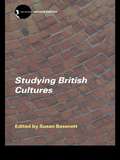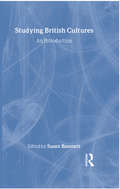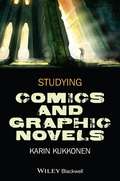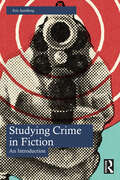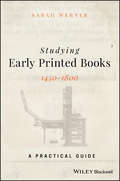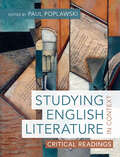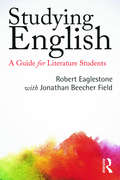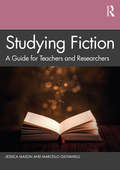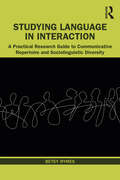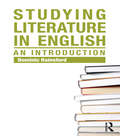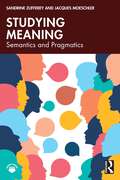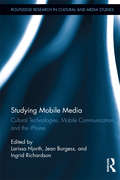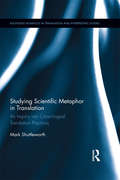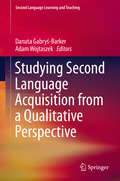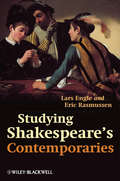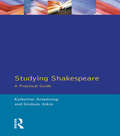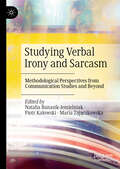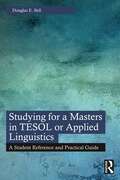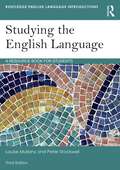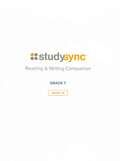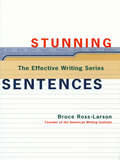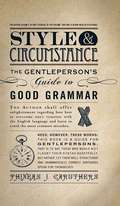- Table View
- List View
Studying British Cultures: An Introduction
by Susan Bassnett'British Studies' and 'British Cultural Studies' cover a wide range of facets of contemporary Britain. Studying British Cultures: An Introduction is a unique collection of essays which examine the most significant aspects of this quickly developing area of study, analyzing the ways of teaching and reading British culture.The work covers the contemporary and key issues, including: the terminological distinction between 'British Studies' and 'British Cultural Studies' the problem of national cultures and identities in contemporary Britain studying language and literature from a British Studies perspective models for studying the historical context of the development of ideas of `Britishness' studying contemporary Britain overseas The contributors are some of the key names in current debates surrounding British Studies, and Susan Bassnett holds together their work with a substantial and accessible introduction. Studying British Cultures: An Introduction will be essential reading for students and teachers concerned with the study of contemporary Britain.
Studying British Cultures: An Introduction (New Accents Ser.)
by Susan BassnettStudying British Cultures is a lively and provocative volume of essays which offers the ideal introduction to a contentious area. The contributors, who have been instrumental in establishing the discipline of British Cultural Studies, explore a wide range of critical debates on cultural identity and explode the myth that Britain is made up of a homogenous people.The first half of the book traces examines the theory and methodology of studying British cultures, in disciplines variously known as British Studies, Cultural Studies or British Cultural Studies. The second half of the book turns to key topics in those fields, looking in turn at developments in Scottish, Welsh and Irish Studies and the roles of Shakespeare and West Indian literature in the study of British cultures. In vivid and often entertaining essays, the authors demonstrate that 'culture' is a plurality of discourses, not a fixed, unitary concept.
Studying Comics and Graphic Novels
by Karin KukkonenThis introduction to studying comics and graphic novels is a structured guide to a popular topic. It deploys new cognitive methods of textual analysis and features activities and exercises throughout. Deploys novel cognitive approaches to analyze the importance of psychological and physical aspects of reader experience Carefully structured to build a sequenced, rounded introduction to the subject Includes study activities, writing exercises, and essay topics throughout Dedicated chapters cover popular sub-genres such as autobiography and literary adaptation
Studying Crime in Fiction: An Introduction
by Eric SandbergThe primary aim of Studying Crime in Fiction: An Introduction is to introduce the emerging cross-disciplinary area of study that combines the fields of crime fiction studies and criminology. The study of crime fiction as a genre has a long history within literary studies, and is becoming increasingly prominent in twenty-first-century scholarship. Less attention, however, has been paid to the ways in which elements of criminology, or the systematic study of crime and criminal behaviour from a wide range of perspectives, have influenced the production and reception of crime narratives. Similarly, not enough attention has been paid to the ways in which crime fiction as a genre can inform and enliven the study of criminology. Written largely for undergraduate and graduate students, but also for scholars of crime fiction and criminology interested in thinking across disciplinary boundaries, Studying Crime in Fiction: An Introduction provides full coverage of the backgrounds of the related fields of crime fiction studies and criminology, and explores the many ways they are reciprocally illuminating. The four main chapters in Section 1 (Orient You) familiarize readers with the history and contours of the broad fields within which Studying Crime in Fiction: An Introduction operates. It introduces the history of crime and criminology, as well the history of crime fiction and the academic field dedicated to its study. In its final chapter it looks at the ways these areas of study can be conceptually interrelated. Section 2 of the book (Equip You) is dedicated to examining aspects of criminological theory in relation to various forms of crime fiction. It highlights a range of the most relevant theories, paradigms, and problematics of criminology that appear in, shed light on, or can be effectively illuminated through reference to crime fiction. Its five chapters deal with the definition of crime; explanations for crime and criminal behaviour; investigations into crime; the experience of crime; and, finally, punishments for crime. All of these areas are examined alongside examples of crime fiction drawn from across the genre’s history. Section 3 (Enable You) presents six case studies. Each of these reads a work of crime fiction alongside one or more criminological approaches. Each case study is supplemented with a set of questions addressing issues central to the study of crime in fiction.
Studying Early Printed Books, 1450-1800: A Practical Guide
by Sarah WernerA comprehensive resource to understanding the hand-press printing of early books Studying Early Printed Books, 1450 - 1800 offers a guide to the fascinating process of how books were printed in the first centuries of the press and shows how the mechanics of making books shapes how we read and understand them. The author offers an insightful overview of how books were made in the hand-press period and then includes an in-depth review of the specific aspects of the printing process. She addresses questions such as: How was paper made? What were different book formats? How did the press work? In addition, the text is filled with illustrative examples that demonstrate how understanding the early processes can be helpful to today’s researchers. Studying Early Printed Books shows the connections between the material form of a book (what it looks like and how it was made), how a book conveys its meaning and how it is used by readers. The author helps readers navigate books by explaining how to tell which parts of a book are the result of early printing practices and which are a result of later changes. The text also offers guidance on: how to approach a book; how to read a catalog record; the difference between using digital facsimiles and books in-hand. This important guide: Reveals how books were made with the advent of the printing press and how they are understood today Offers information on how to use digital reproductions of early printed books as well as how to work in a rare books library Contains a useful glossary and a detailed list of recommended readings Includes a companion website for further research Written for students of book history, materiality of text and history of information, Studying Early Printed Books explores the many aspects of the early printing process of books and explains how their form is understood today.
Studying English Literature in Context: Critical Readings
by Paul PoplawskiRanging from early medieval times to the present, this diverse collection explores the myriad ways in which literary texts are informed by their historical contexts. The thirty-one chapters draw on varied themes and perspectives to present stimulating new readings of both canonical and non-canonical texts and authors. Written in a lively and engaging style, by an international team of experts, these specially commissioned essays collectively represent an incisive contribution to literary studies; they will appeal to scholars, teachers and graduate and undergraduate students. The book is designed to complement Paul Poplawski's previous volume, English Literature in Context, and incorporates additional study elements designed specifically with undergraduates in mind. With an extensive chronology, a glossary of critical terms, and a study guide suggesting how students might learn from the essays in their own writing practices, this volume provides a rich and flexible resource for teaching and learning.
Studying English Literature: A Practical Guide
by Tory YoungStudying English Literature is a unique guide for undergraduates beginning to study the discipline of literature and those who are thinking of doing so. Unlike books that provide a survey of literary history or non-subject specific manuals that offer rigid guidelines on how to write essays, Studying English Literature invites students to engage with the subject's history and theory whilst at the same time offering information about reading, researching and writing about literature within the context of a university. The book is practical yet not patronizing: for example, whilst the discussion of plagiarism provides clear guidelines on how not to commit this offence, it also considers the difficulties students experience finding their own 'voice' when writing and provokes reflection on the value of originality and the concepts of adaptation, appropriation and intertextuality in literature. Above all, the book prizes the idea of argument rather than insisting upon formulaic essay plans, and gives many ways of finding something to say as you read and when you write, in chapters on Reading, Argument, Essays, Sentences and References.
Studying English: A Guide for Literature Students (Routledge Study Guides Ser. #Volume 71)
by Robert Eaglestone with Jonathan Beecher FieldClearly focussed on the needs of students, Robert Eaglestone and Jonathan Beecher Field have revised the best-selling Doing English specifically for English literature courses in America. Studying English presents the ideas and debates that shape literary studies in America today. This overview of the discipline explains not only what students need to know, but how and why English came to be the way it is. This uniquely comprehensive guide to the subject gives students the background they need to understand and enjoy their studies more fully. The book covers arguments about criticism and theory, value, the canon, Shakespeare, authorial intention, figural language, narrative, writing, identity, politics and the skills that are learned from studying English for the world of work. In a clear and engaging way, Robert Eaglestone and Jonathan Beecher Field: Orient you, by exploring what it is to study English in America now. Equip you, by explaining the key ideas and trends in English in context. Enable you to begin higher level study.
Studying Fiction: A Guide for Teachers and Researchers
by Marcello Giovanelli Jessica MasonStudying Fiction provides a clear rationale alongside ideas and methods for teaching literature in schools from a cognitive linguistic perspective. Written by experienced linguists, teachers and researchers, it offers an overview of recent studies on reading and the mind, providing a detailed guide to concepts such as attention, knowledge, empathy, immersion, authorial intention, characterisation and social justice. The book synthesises research from cognitive linguistics in an applied way so that teachers and those researching English in education can consider ways to approach literary reading in the classroom. Each chapter: draws on the latest research in cognitive stylistics and cognitive poetics; discusses a range of ideas related to the whole experience of conceptualising teaching fiction in the classroom and enacting it through practice; provides activities and reflection exercises for the practitioner; encourages engagement with important issues such as social justice, emotion and curriculum design. Together with detailed suggestions for further reading and a guide to available resources, this is an essential guide for all secondary English teachers as well as those teaching and researching in primary and undergraduate phases.
Studying Language in Interaction: A Practical Research Guide to Communicative Repertoire and Sociolinguistic Diversity
by Betsy RymesStudying Language in Interaction is a holistic practical guide with a hybrid purpose: To emphasize a particular approach to language in the world—a theory of language that has room for communicative repertoire and sociolinguistic diversity—and to provide a practical guide for new researchers of language in interaction. Each chapter focuses on one way of communicating, providing a set of strategies to observe, note, and reflect on context-specific ways of using multiple languages, of sounding, naming, using social media, telling stories, being ironic, and engaging in everyday routines. This approach provides a practical guide without stripping out all the wonder and nuance of language in interaction that originally draws the novice researcher to critical inquiry and makes language relevant to the humans who use it every day. Studying Language in Interaction is not only a practical research guide; it is also a workbook for being in the world in ways that matter, illustrating that any research on language in interaction involves both tricks of the trade and a sustained engagement with humanity. With extensive pedagogical resources, this is an ideal text for advanced undergraduate and graduate students of sociolinguistics, intercultural communication, linguistic anthropology, and education who are embarking on fieldwork projects.
Studying Literature in English: An Introduction
by Dominic RainsfordStudying Literature in English provides the ideal point of entry for students of English Literature. This book is an accessible guide for Literature students around the world. This book: Grounds literature and the study of literature throughout by referencing a selection of well-known novels, plays and poems Examines the central questions that readers ask when confronting literary texts, and shows how these make literary theory meaningful and necessary Links British, American and postcolonial literature into a coherent whole Discusses film as literature and provides the basic conceptual tools in order to study film within a literature-course framework Places particular emphasis on interdisciplinarity by examining the connections between the study of literature and other disciplines Provides an annotated list of further reading From principal literary genres, periods and theory, to strategies for reading, research and essay-writing, Dominic Rainsford provides an engaging introduction to the most important aspects of studying literature in English. This book is invaluable reading for anyone studying literature in English.
Studying Meaning: Semantics and Pragmatics
by Sandrine Zufferey Jacques MoeschlerStudying Meaning provides a comprehensive introduction to semantics and pragmatics, covering all key concepts and new developments in an accessible manner. By introducing semantics and pragmatics together, the book compares their contributions to meaning and provides a coherent view. It also highlights where the boundaries between these disciplines lie.The 14 chapters trace the historical development of semantics and pragmatics and incorporate recent subfields such as cognitive semantics, embodiment theories, and intercultural pragmatics. The book offers an up-to-date overview of research methodologies, drawing on examples from various languages and empirical data from corpora. Each chapter ends with a list of questions and exercises. This text provides an accessible yet comprehensive exploration of how meaning is conveyed in communication, covering linguistic, cognitive, and social aspects. Online support materials are provided to enhance and deepen understanding of the text.Assuming no prior knowledge, this is essential reading for students of semantics, pragmatics, linguistics, and related fields.
Studying Mobile Media: Cultural Technologies, Mobile Communication, and the iPhone (Routledge Research in Cultural and Media Studies)
by Jean Burgess Larissa Hjorth Ingrid RichardsonThe iPhone represents an important moment in both the short history of mobile media and the long history of cultural technologies. Like the Walkman of the 1980s, it marks a juncture in which notions about identity, individualism, lifestyle and sociality require rearticulation. this book explores not only the iPhone’s particular characteristics, uses and "affects," but also how the "iPhone moment" functions as a barometer for broader patterns of change. In the iPhone moment, this study considers the convergent trajectories in the evolution of digital and mobile culture, and their implications for future scholarship. Through the lens of the iPhone—as a symbol, culture and a set of material practices around contemporary convergent mobile media—the essays collected here explore the most productive theoretical and methodological approaches for grasping media practice, consumer culture and networked communication in the twenty-first century.
Studying Scientific Metaphor in Translation (Routledge Advances in Translation and Interpreting Studies)
by Mark ShuttleworthStudying Scientific Metaphor in Translation presents a multilingual examination of the translation of metaphors. Mark Shuttleworth explores this facet of translation and develops a theoretically nuanced description of the procedures that translators have recourse to when translating metaphorical language. Drawing on a core corpus consisting of six Scientific American articles in the fields of neurobiology and biotechnology dating from 2004, along with their translations into Chinese, French, German, Italian, Polish and Russian, Shuttleworth provides a data-driven and theoretically informed picture of the processes that underpin metaphor translation. The book builds interdisciplinary bridges between translation scholars and metaphor researchers, proposes a new set of procedures for metaphor translation conceived within the context of descriptive translation studies, and puts forward a possible resolution to the debate on metaphor translatability.
Studying Second Language Acquisition from a Qualitative Perspective
by Danuta Gabryś-Barker Adam WojtaszekThis book presents a selection of empirical papers dealing with second and multiple language acquisition, in which qualitative research methodology is employed. Each of the studies reported in individual chapters is based on a solid theoretical background and an overview of studies in a given area. Although the main focus is on qualitative methods, some of the papers demonstrate the complementarity of quantitative and qualitative approaches in studying language acquisition.
Studying Shakespeare's Contemporaries
by Eric Rasmussen Lars EngleStudying Shakespeare’s Contemporaries is an accessible guide to non-Shakespearian English drama of the late 16th and early 17th centuries. Featuring works of prestigious playwrights such as Kyd, Marlowe, Jonson, Webster, and Middleton, Lars Engle describes the conditions under which Renaissance plays were commissioned, written, licensed, staged, and published. Plays are organized by theme and explored individually, creating a text that can be read as a complete overview of English Renaissance drama or used as an indexed reference resource.
Studying Shakespeare: A Practical Introduction
by Katherine Armstrong Graham AtkinThis book is a concise single volume guide to studying Shakespeare, covering practical as well as theoretical issues. The text deals with the major topics on a chapter-by-chapter basis, starting with why we study Shakespeare, through Shakespeare and multimedia, to a final chapter on Shakespeare and Theory. Current trends and recent developments in Shakespearean studies are also discussed, with an emphasis on the contextualisation of Shakespeare, historical appropriations of his work and the debate concerning his place in the literary canon. Extensive reference is made to a variety of developing media, e.g. film, audio cassette, video, CD-Rom and global digital networks, bringing the study of Shakespeare into the twentieth century.
Studying Verbal Irony and Sarcasm: Methodological Perspectives from Communication Studies and Beyond
by Natalia Banasik-Jemielniak Piotr Kałowski Maria ZajączkowskaThis volume provides a comprehensive yet accessible introduction to the phenomenon of verbal irony and sarcasm and the methodological aspects of its study. The chapters employ quantitative and qualitative measures of the use of verbal irony and sarcasm in both adults and children, with methods ranging from questionnaires and comment elicitation through experimental studies to a qualitative analysis of naturalistic data. By examining the phenomena in a range of contexts, the volume also show that cultural norms of communication may affect both the use and understanding of irony in specific ways and should therefore be taken into account in research.
Studying for a Masters in TESOL or Applied Linguistics: A Student Reference and Practical Guide
by Douglas E. BellStudying for a Masters in TESOL or Applied Linguistics provides the definitive go-to text for all students studying an MA in TESOL or Applied Linguistics, as well as closely related degrees such as an MA in English Language Teaching. Written in a clear and user-friendly format and drawing on authentic and highly relevant source materials with the inclusion of practical tasks and answer keys for self-correction throughout, this book demystifies each stage of the MA TESOL/MA Applied Linguistics journey. Covering practical programme components, such as lesson observation and teaching practice, this book helps the reader to develop the key skills required to successfully complete an MA including: How to effectively manage your time How to get the most out of your lectures How to develop effective reading skills How to become a better academic writer How to deal with various types of assessments How to deliver effective oral presentations Guiding students step by step through the process of how to choose, research and then write a successful dissertation, the book closes with guidance and tips for students on how to proceed after completing an MA in TESOL/Applied Linguistics. This book is therefore essential reading for those contemplating or undertaking an MA in either of these areas.
Studying the English Language: A Resource Book for Students (Routledge English Language Introductions)
by Peter Stockwell Louise MullanyRoutledge English Language Introductions cover core areas of language study and are one-stop resources for students. Assuming no prior knowledge, books in the series offer an accessible overview of the subject, with activities, study questions, sample analyses and commentaries.Revised throughout, the third edition of Studying the English Language (previously Introducing English Language) covers the key disciplines and concepts of linguistics as well as core areas in language study, including acquisition, standardisation and the globalisation of English. The new edition offers:- An updated and more accessible structure with separate threads on semantics, pragmatics, text and discourse, and new material on identity- A new thread on ‘Meanings’, focusing purely on semantics, including both lexical semantics and new material on propositional semantics- New explanations on relevance theory, text linguistics, corpus linguistics and Critical Discourse Analysis (CDA)- A more international outlook with the inclusion of bilingual views, a discussion of post-colonial power and a revised section on Global Englishes- Coverage of new developments in areas such as politeness, discourse analysis, text-worlds, cognitive poetics and corpus stylistics- Updated further reading recommendations, examples and exercises- A re-imagined D section with a diverse range of resources, including passages of key texts and the authors’ own research, questions, prompts and guidance to engage with the texts, summaries of key works with discussion points and guidance for further research.Written by two experienced teachers and authors, this accessible introduction to the study of English language is an essential resource for all students of English language and linguistics.
Studysync Core Ela Grade 7, Hardcover Student Reading And Writing Companion
by StudySync McGraw Hill LlcStudySync Core ELA Grade 7, Hardcover Student Reading and Writing Companion (MS STUDY SYNC) 1st Edition
Studysync: Reading & Writing Companion GRADE 7 UNITS
by Llc Bookheaded LearningLiterature Anthology Textbook for 7th Grade
Stuff of Sleep and Dreams: Experiments in Literary Psychology
by Leon EdelA critical look at the psychological footprints of some authors. As well as a study of the psychological basis of the contradictory nature of authors and the characters they create, as when divorced from their craft.
Stunning Sentences (The Effective Writing Series)
by Bruce Ross-LarsonWhether you are composing a Web page on the Internet or agonizing over an annual budget report, these books are the key to clarity, accuracy, and economy in any writing task. Offers more than 100 model sentence types in a catalog format, giving writers many interesting and provocative ways to say what they mean. Writers looking for a more striking way to open a sentence will find these options: the announcement, the editorial opening, the opening appositive, the opening absolute, and the conjunction opening, among others. Examples of each sentence type ensure the reader's understanding of the concepts.
Style & Circumstance
by Phineas J. CaruthersStressed over syntax? Unsure about noun/verb agreement? Afraid to commit a grammatical faux pas? Fear not, dear reader. You have found yourself the perfect guide to proper grammar and style. This refresher on the modern rules of writing will help you regain your masterful grip of the English language. With plenty of instruction as well as a little pomp, this book entertains as it enlightens, making your reading experience enjoyable and your knowledge sound.
